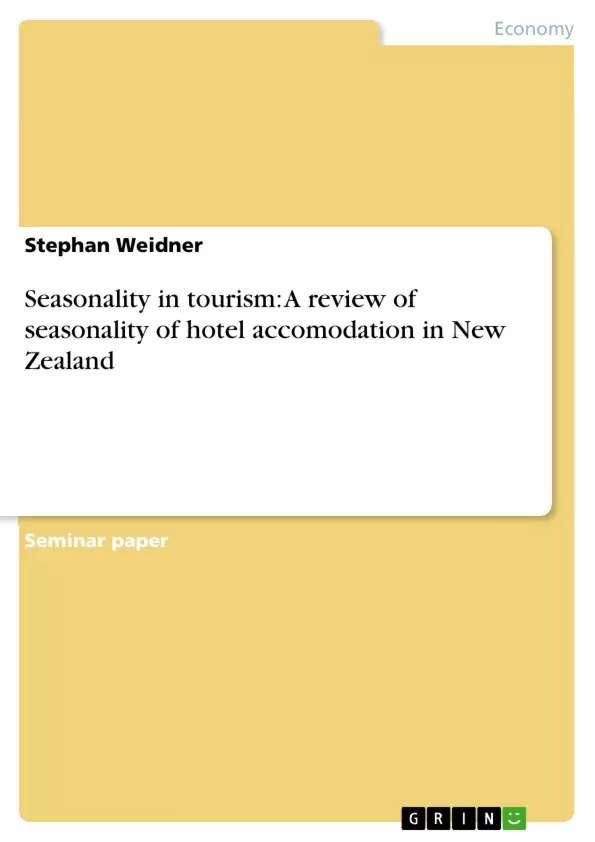This paper outlines the main facts about the topic “seasonality” in general with special consideration given to the hotel industry of New Zealand. The aim of this article is to recognise and understand the patterns of seasonality in this industry. For a better understanding the term “seasonality” and the different ways of measuring it are briefly described. Particular attention is paid to the definition of the relevant data sets and the capacity effect. The findings are based on reliable statistical data taken from a specialised institution in New Zealand.
Inhaltsverzeichnis (Table of Contents)
- Abstract
- Introduction
- Seasonality
- Definition
- Measurement
- Particularities of the New Zealand tourism market
- Statistical Data
- Methodology
- Raw Data
- Findings
- Conclusions
- Sources
Zielsetzung und Themenschwerpunkte (Objectives and Key Themes)
This paper aims to analyze the seasonality patterns in New Zealand's hotel industry. It seeks to understand the characteristics of this seasonality and its implications for the industry. The study utilizes various methods to measure seasonality and presents findings through graphical illustrations.
- Definition and measurement of seasonality in tourism.
- Specific characteristics of seasonality in the New Zealand tourism market.
- Analysis of statistical data on visitor arrivals, guest nights, and room nights.
- Application of various methods to measure seasonality.
- Presentation of findings and conclusions based on the data analysis.
Zusammenfassung der Kapitel (Chapter Summaries)
Abstract: This abstract provides a concise overview of the paper, highlighting its focus on seasonality in New Zealand's hotel industry. It mentions the exploration of seasonality definitions and measurement methods, emphasizing the use of statistical data and graphical illustrations to present the findings.
Introduction: The introduction establishes the importance of seasonality in the tourism industry, emphasizing both its potential negative economic, ecological, and social impacts and the opportunities for recovery during off-peak seasons. The paper's objective is clearly defined: to illustrate the demand patterns in New Zealand's hotel industry through analysis of visitor arrivals, guest nights, and room nights, employing various measurement techniques and graphical representations.
Seasonality: This chapter defines seasonality in tourism, citing Butler (1994) and others, and explores various causes, including natural (weather, geography) and institutional factors (holidays, events). It differentiates between single-peak, two-peak, non-peak, and dynamic seasonality patterns (Butler and Mao, 1996), and discusses the economic significance of predictable tourist recurrence (Hartmann, 1986) and the relationship between destination specialization and seasonality (WTO, 1984).
Methodology: This section outlines the methods used in the study. It details the process of data collection, outlining how the relevant datasets were defined, and specifies the chosen statistical methods for measuring seasonality. This would include explaining the specific calculations and techniques used to analyze the data, setting the groundwork for interpreting the results presented in the findings section.
Schlüsselwörter (Keywords)
Seasonality, tourism, New Zealand, hotel industry, capacity, calendar effect, capacity effect, statistical data analysis, visitor arrivals, guest nights, room nights, Gini coefficient.
Frequently Asked Questions: Seasonality in New Zealand's Hotel Industry
What is the overall topic of this document?
This document is a comprehensive preview of a research paper analyzing seasonality patterns within New Zealand's hotel industry. It provides a table of contents, objectives, key themes, chapter summaries, and keywords.
What are the main objectives of the research paper?
The paper aims to analyze seasonality patterns in New Zealand's hotel industry, understand the characteristics of this seasonality, and explore its implications for the industry. It uses various methods to measure seasonality and presents findings through graphical illustrations. Specific objectives include defining and measuring seasonality in tourism, analyzing statistical data (visitor arrivals, guest nights, room nights), applying various seasonality measurement methods, and presenting conclusions based on data analysis.
What key themes are addressed in the research?
Key themes include the definition and measurement of seasonality in tourism, the specific characteristics of seasonality in the New Zealand tourism market, and the analysis of statistical data related to visitor arrivals, guest nights, and room nights. The research also covers the application of various methods to measure seasonality and the presentation of findings and conclusions.
What is included in the "Seasonality" chapter?
This chapter defines seasonality in tourism, referencing relevant literature such as Butler (1994), Butler and Mao (1996), Hartmann (1986), and WTO (1984). It explores the causes of seasonality (natural and institutional factors), differentiates between various seasonality patterns (single-peak, two-peak, non-peak, dynamic), and discusses the economic significance of predictable tourist recurrence and the relationship between destination specialization and seasonality.
What methodologies are used in the research?
The methodology section details the data collection process, defining the relevant datasets and specifying the statistical methods used to measure seasonality. It explains the calculations and techniques employed to analyze the data, providing the basis for interpreting the results presented in the findings section.
What type of data is analyzed in this research?
The research analyzes statistical data on visitor arrivals, guest nights, and room nights in New Zealand's hotel industry to understand seasonality patterns.
What are the key words associated with this research?
Key words include: Seasonality, tourism, New Zealand, hotel industry, capacity, calendar effect, capacity effect, statistical data analysis, visitor arrivals, guest nights, room nights, Gini coefficient.
What does the abstract cover?
The abstract provides a concise overview of the paper, highlighting its focus on seasonality in New Zealand's hotel industry. It mentions the exploration of seasonality definitions and measurement methods, emphasizing the use of statistical data and graphical illustrations to present the findings.
What is covered in the introduction?
The introduction establishes the importance of seasonality in the tourism industry, highlighting its potential negative economic, ecological, and social impacts, and the opportunities for recovery during off-peak seasons. It clearly defines the paper's objective: to illustrate demand patterns in New Zealand's hotel industry through analysis of visitor arrivals, guest nights, and room nights, using various measurement techniques and graphical representations.
- Quote paper
- Stephan Weidner (Author), 2006, Seasonality in tourism: A review of seasonality of hotel accomodation in New Zealand, Munich, GRIN Verlag, https://www.grin.com/document/122991



